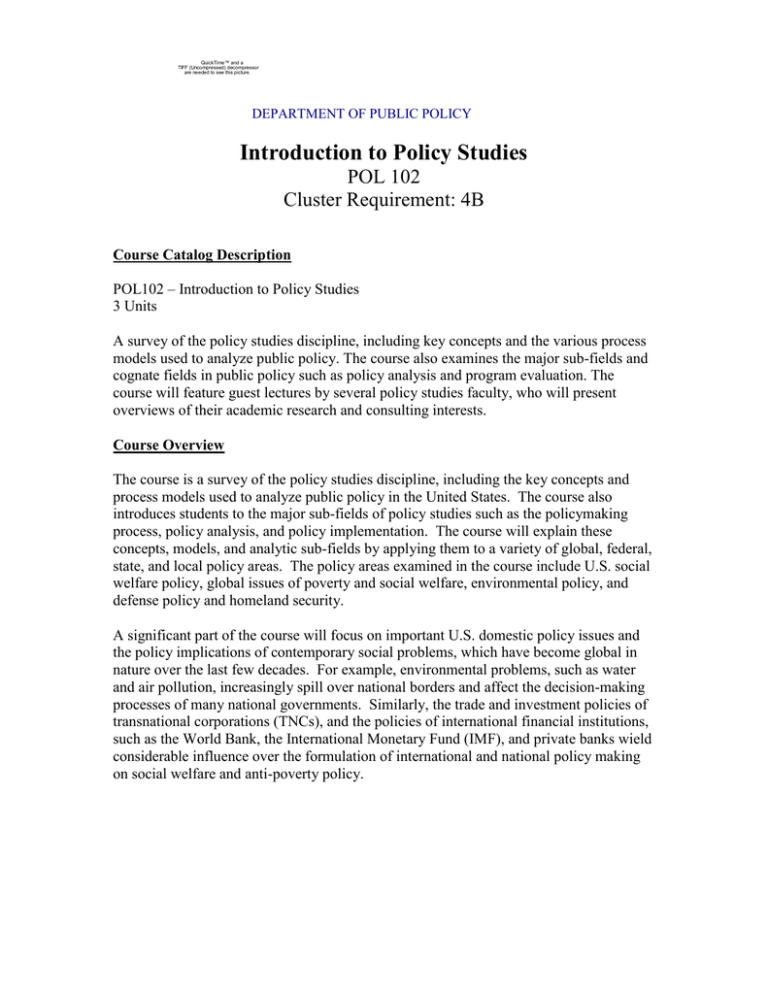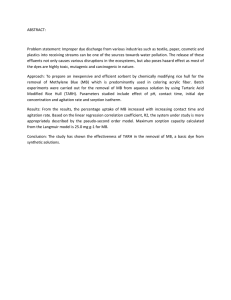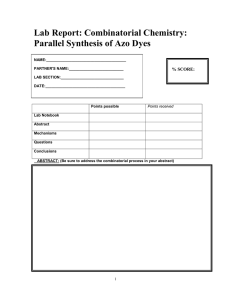Introduction to Policy Studies POL 102 Cluster Requirement: 4B
advertisement

QuickTime™ and a TIFF (Uncompressed) decompressor are needed to see this picture. DEPARTMENT OF PUBLIC POLICY Introduction to Policy Studies POL 102 Cluster Requirement: 4B Course Catalog Description POL102 – Introduction to Policy Studies 3 Units A survey of the policy studies discipline, including key concepts and the various process models used to analyze public policy. The course also examines the major sub-fields and cognate fields in public policy such as policy analysis and program evaluation. The course will feature guest lectures by several policy studies faculty, who will present overviews of their academic research and consulting interests. Course Overview The course is a survey of the policy studies discipline, including the key concepts and process models used to analyze public policy in the United States. The course also introduces students to the major sub-fields of policy studies such as the policymaking process, policy analysis, and policy implementation. The course will explain these concepts, models, and analytic sub-fields by applying them to a variety of global, federal, state, and local policy areas. The policy areas examined in the course include U.S. social welfare policy, global issues of poverty and social welfare, environmental policy, and defense policy and homeland security. A significant part of the course will focus on important U.S. domestic policy issues and the policy implications of contemporary social problems, which have become global in nature over the last few decades. For example, environmental problems, such as water and air pollution, increasingly spill over national borders and affect the decision-making processes of many national governments. Similarly, the trade and investment policies of transnational corporations (TNCs), and the policies of international financial institutions, such as the World Bank, the International Monetary Fund (IMF), and private banks wield considerable influence over the formulation of international and national policy making on social welfare and anti-poverty policy. Page 2 of 8 – Introduction to Policy Studies, POL 102 Course Rationale The course is intended to introduce students to the role of policy in the development and evolution of government in the United States. Through understanding policy as a process, students are exposed to the framework in which government identifies, creates, implements, and evaluates its actions. In addition, students are exposed to policy analysis, which engages their critical thinking skills as related to meaningfully deciphering policyrelevant distinctions such as outcomes versus impacts on U.S. public government institutions. Evidence of the ability to comprehend the materials presented is done through weekly quizzes, discussion board responses, and multiple-choice examinations. Evidence of critical is measured through case studies and a written assignment where a policy is chosen, analyzed, and evaluated using techniques policy analysis techniques described in the course. Learning Outcomes Course-Specific Learning Outcomes: The class is designed to develop and document basic retention skills in three areas: 1. to demonstrate a substantive understanding of the major concepts and process models used to analyze public policy-making 2. to develop a knowledge of the major actors (formal and informal) and their roles in the policy-making process, and 3. to develop a basic substantive knowledge of key policy areas, such as welfare, civil rights, and environmental policy. In addition, the class is designed to develop and test critical thinking (analytical) skills by presenting the student with a policy for written review and evaluation based on the techniques of policy analysis developed in the course. University Studies Learning Outcomes: This course meets the learning outcomes identified in University Studies, specifically Cluster 4B: The Social World: Humanity and Society: The Nature of U.S. Society. This includes the following: explaining the development of U.S. culture and sub-culture from different perspectives; locating, analyzing, summarizing, paraphrasing and synthesizing material from a variety of sources; and evaluating arguments made in support of different perspectives on U.S. society. Page 3 of 8 – Introduction to Policy Studies, POL 102 Examples of Texts Thomas R. Dye, Understanding Public Policy, 14th Edition (2012) Example Assignments Overview Assignment Readings Discussion Board Interactions Written Papers Examinations Relationship to University Studies Outcomes Text and materials introduce students to policy development, implementation, and evaluation. All materials help the student understand the nature of U.S. Society in terms of the policy-making process. Students answer questions related to public policy concepts that include the development of U.S. culture through the synthesizing responses to questions that derive from a variety of sources, including arguments supporting different perspectives of U.S. Society. Students develop papers that identify a public policy issue in that helps them synthesize and analyze the policy making process from different perspectives of U.S. Society. Exams help students to reinforce basic concepts of how public policy helps to define the nature of U.S. Society. Examples Examinations – University Learning Outcomes Category 4B1: Multiple Choice Questions for learning reinforcement of basic concepts: Course Specific Learning Outcomes: 1, 2, 3. According to the text, ____________ is a common indicator of governmental functions and priorities. a. policy advocacy b. government spending c. regulatory activity d. policy analysis Page 4 of 8 – Introduction to Policy Studies, POL 102 Traditional political science focuses primarily on a. causes of government activity. b. the behavioral processes of government. c. the institutional arrangements (e.g., constitutional requirements) of government. d. an evaluation of the consequences of societal policies. Those interested in the three major branches of government (executive, legislative, and judicial) would be primarily interested in the a. institutional model. b. the game theory model. c. public choice model. d. rational model. To make a rational policy decision, the makers must a. know some of the policy alternatives that are available. b. know some of the values of society. c. know the consequences of some of the various policy alternatives. d. select the most efficient policy alternative. Essay Questions: Course Specific Learning Outcomes: 1, 2, 3. Rubric: Answer each question fully. Points are awarded based on whether the question was answered in the manner asked, whether sub-parts of the question were answered, and the degree to which the student showed evidence of comprehension and understanding (beyond describing a response). 10 points each. Grading Criteria The response answers all parts of the question asked. The response includes evidence and examples, where appropriate, to support the answer. The response includes analysis where appropriate that goes beyond describing the answer but gives context to show the student understands the context of the question including identifying any limitations that might apply in the response. The response is well-written in clear English with little to no grammatical errors. Weight 25% 25% 30% 20% Page 5 of 8 – Introduction to Policy Studies, POL 102 The agenda setting process can be viewed from the bottom-up or top-down perspective. Explain. Give examples. What is the federal government’s role in law enforcement? Include a discussion of the constitutional constraints. The United States spends more of its resources on health care than any advanced industrialized nation, yet it ranks below other nations in many key health measures. Why? Address access, education, and prevention. The impact of policy includes both its symbolic and tangible effect. Explain the symbolic effects. Major Written Assignment – University Learning Outcomes Category 4B 2 and 3: Paper Assignment: Purpose The purpose of the course paper is to get each of you to analyze a policy topic using evaluative measurements discussed in the course. Specifically, I want each of you to use either benefit-cost analysis or cost-effectiveness analysis as the means of evaluating your chosen topic. The purpose is to see how you apply the materials we discuss this semester to your chosen topic. The manner in which you apply the materials will show your overall comprehension of the materials and how well you can apply the concepts learned in the course to an actual policy. Details As mentioned above, you must use either benefit-cost analysis or cost-effectiveness analysis as the primary means of evaluating your chosen topic. In addition, you must use total use valuation in establishing your criteria for analysis (this will become clear early in the course). So, in layman’s terms, you will be choosing a topic of interest. You will then determine all associated values impacted in your topic (direct use, indirect use, and non-use values) – this will give you your total valuation. You will then apply either benefit-cost analysis (preferred), or cost-effectiveness analysis to your chosen topic. In order to apply these analytical tools, you must “frame” your question (read: topic) quite clearly. For example, an acceptable question to use these analytical tools might be as follows: The “Dead Zone” in the Gulf of Mexico: does it make economic sense to limit fertilizer use along the Mississippi River Watershed as a means of protecting the Gulf’s resources? Page 6 of 8 – Introduction to Policy Studies, POL 102 Can you see how “framing” the topic in terms of a question helps to set up the analysis in the paper? This is what I want each of you to do in your papers. Your answer to the question will be based, in large part, on which criteria you choose to analyze, and the values you determine for each criteria. For example, wetlands might be one criteria in the “Dead Zone” topic above. Depending on the values you determine to be associated with wetlands, your ultimate conclusion about benefits vs. costs will likely differ. Contents of Paper The paper will be at least 5 pages, 1-inch margins, typed (12 point font) and doublespaced. This is exactly how you must submit the paper, no exceptions! You will be specifically graded on how well you follow directions. In terms of sectioning your paper, I have a suggested outline approach that can be used below: I. Introduction: Describe the selected topic and establish its importance (why is this my question, and why I am looking at it this way) II. Literature Review: Review the literature that deals with the topic you have selected (what have others said in this area) III. Analysis of the Literature: Analyze and critique the literature (what has been done. Does it take into consideration total valuation – why not?) IV. Application of Theoretical Framework: Which theoretical framework(s) of public policymaking best applies to the development of the environmental policy you have chosen to study (I am forcing you to choose benefit-cost analysis or cost-effectiveness) V. Summary and Conclusion: Summarize your arguments. Give your opinion about what should be done along with a brief statement of support. VI. References. This is only a suggested outline – you are free to modify your own outline. Deliverables You will be required to submit three deliverables during the course: 1. A topic with a brief explanation why you are choosing this topic and how you will go about analyzing the topic. 2. A detailed outline showing the major sections of your paper, and summarizing what will be described in each section. Page 7 of 8 – Introduction to Policy Studies, POL 102 3. A final paper product. Grading Grading Criteria Meeting length, format requirements, and deadlines Overall clarity of the content – is the paper clearly written, presented in a logical format, and responsive to the question being asked (policy being analyzed)? Proof of editing (few to no mistakes apparent in the paper) Proof of analytical reasoning used in evaluating the policy under consideration. Use of sources (have primary sources been utilized and properly attributed?). Weight 20% 25% 20% 20% 15% Sample Course Outline Module One Topic Policy Analysis - Dye, Chapter 1 Two Models of Politics - Dye, Chapter 2 Three The Policymaking Process - Dye, Chapter 3 Four Policy Evaluation - Dye, Chapter 15 Five Policy in Context: Criminal Justice - Dye, Chapter 4 Six Health and Welfare - Dye, Chapter 5 Seven Education - Dye, Chapter 6 Eight Tax Policy - Dye, Chapter 8 Nine International Trade and Immigration Page 8 of 8 – Introduction to Policy Studies, POL 102 - Dye, Chapter 9 Ten Environmental Policy - Dye, Chapter 10 Eleven Environmental Policy (cont’d) - Handouts online Twelve Civil Rights - Dye, Chapter 11 Thirteen Defense Policy - Dye, Chapter 13


